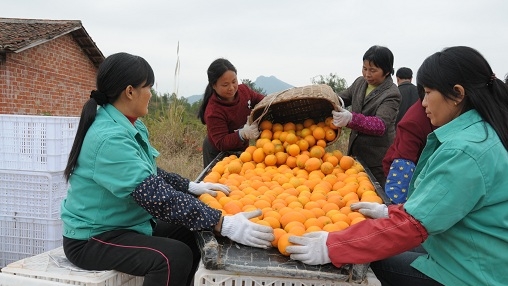Overview
In 2004, the World Bank launched a project to improve the livelihoods of rural households in China’s Jiangxi Province through agricultural modernization. It supported the establishment of integrated, market –driven agricultural production systems that are economically and environmentally sustainable in order to increase productivity and generate agricultural output of high quality and value. By the project’s completion in 2010, some 267,000 households representing 1.3 million people in Jiangxi Province had benefited from higher agricultural production and incomes.
Challenge
Agriculture, rural development and farmers are among the top concerns and priorities of the Chinese Government. China is facing dual challenges to ensure food security to its large and still growing population and to improve the living standards of the rural population. In recent years, the growth in agriculture and the rural sector slowed and the increase in farm incomes was lagging behind that of non-agricultural incomes. Sustainable stable growth in agriculture and ensuring food security are key areas of the Government's development plans. With increasing income levels in the urban areas and more sophisticated consumer demand, there is also a shift in the focus from the quantity of food supply towards cost effectiveness, larger diversity and quality of agricultural products.
Approach
Through the project in Jiangxi Province, the Bank introduced an integrated approach to agricultural development and modernization. The approach comprised:
The rehabilitation and extension of existing irrigation and drainage systems, combined with the establishment of self-financed irrigation and drainage development systems and water user's associations to ensure more efficient and sustainable use of land and water resources for irrigated agriculture.
Improvement in farm production systems to develop higher-value agricultural production, including irrigated field crops, livestock, small-scale on-farm fish production and upland crops.
Development of a market system, through the provision of marketing advice, promotion of farmers' marketing groups, support to agro-enterprises, agricultural product markets and "marketing assistance grants" to support strategic market studies, promotion of the adoption and use of quality standards, and improvements to market information systems.
Results
Between 2004 and 2010, the project achieved remarkable results:
About 1.3 million people in 267,000 rural households in 21 project counties in Jiangxi Province benefited from better irrigation systems, increased agricultural production, and higher incomes.
The average per capita incomes of the famers in the project areas increased to about US$517 a year from about US$340.
210 farm irrigation systems and 772 orchard irrigation systems were improved.
218 water user’s associations were established, resulting in more sustainable operation of irrigation systems and utilization of water resources.
The irrigation reliability of irrigation systems was raised to 80% from 40% in farm irrigation schemes.
Paddy production in the project areas was increased by 480 kg/ha (close to 10%), and navel orange production by 5,715 kg/ha (about 60%).
Four agro-markets, 16 small agro-processing enterprises, 126 leading specialized households and one farmer marketing group were established.
Bank Contribution
The total project cost was US$162.2 million, financed by a loan of US$100 million from the International Bank for Reconstruction and Development and by US$62.2 million from the Government and beneficiaries.
In addition to financing, the Bank’s global knowledge and extensive experience added value to the Jiangxi Provincial Government’s efforts to provide an enabling environment for future economic growth in Jiangxi while accelerating the modernization process of its agricultural sector.
In particular, the Bank provided support to:
Introducing advanced integrated agricultural modernization approach.
Institutionalizing reforms necessary for the sustainable use of water resources.
Introducing new production and processing technologies.
Promoting better production management and providing knowledge of commercial agricultural production and marketing to enable producers to respond to market demand.
Partners
The Bank-Netherlands Water Partnership Program provided US$70,000 for dam safety training. The Department for International Development of the United Kingdom provided US$100,000 for training of water user’s associations.
Toward the Future
The integrated agricultural modernization approach has been scaled up to the rest of Jiangxi Province and also extended to other provinces in China including Hunan, Hubei, Fujian, Henan, Guizhou, and Sichuan Provinces.

